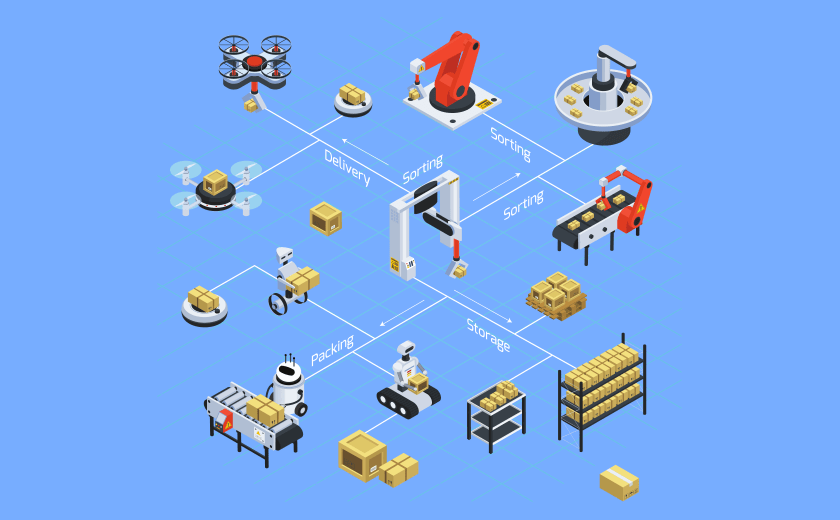AI in Food Manufacturing: How Artificial Intelligence is Transforming Food Production

Every year in the United States, 30% of all food and drink is thrown away, equivalent to $48.3 billion. Inefficient inventory management, poor optimization of delivery schedules, and inaccurate demand forecasting increase the likelihood of waste. Accordingly, successful supply chain management is no longer a competing business advantage but a necessity.
At the same time, the consumer is becoming more demanding, preferring more personalized, fast, and affordable food options. The good news is that Artificial Intelligence in food manufacturing can address these and other challenges.
What processes can be automated using robotics? How do AI technologies improve product quality, supply chain efficiency, and customer satisfaction? In this article, we will break down the use of robotics and AI and discuss real-life platforms already implementing them. You will also learn what to consider when adopting such solutions.
The Integrio team has been developing progressive custom software using AI/ML technologies for over 20 years. And today, we want to share valuable insights about using advanced solutions in the food industry.
How AI and Robotics are Transforming the Future of the Food Processing Automation
Today, businesses face several challenges, such as inconsistent quality control, operational inefficiencies, rising labor costs, food safety concerns, and the need for enhanced traceability. Food industry automation processes help companies address existing problems and improve efficiency and productivity.
AI-powered systems can analyze large volumes of data to optimize production schedules, predict demand patterns, and improve supply chain management. Conversely, robots automate repetitive and labor-intensive tasks, such as sorting and packaging, increasing productivity and reducing costs.
AI Robotics in Food Manufacturing
Robotics plays a crucial role in food production automation, offering numerous advantages in efficiency, precision, and safety.
Use it to streamline operations, increase productivity, improve product quality, and reduce labor costs. By automating repetitive and labor-intensive tasks, robots allow human workers to focus on more complex and value-added activities.
Here are some ideas of how robotics is utilized in food manufacturing:
Automated Packaging
Delegate product picking, placing, and sealing to robots. They can also handle delicate or fragile food items with precision, minimizing product damage. This way, you ensure consistent packaging quality, reduce errors, and increase process speed.
Sorting and Inspection
How about robots with advanced vision systems for food sorting and inspection? They identify defects, sort products based on size, shape, or color, and remove any contaminated items from the production line. Use it to maintain product quality and safety standards.
Material Handling
Automation food technologies help companies transport ingredients, raw materials, and finished products within the production area, reducing manual effort and minimizing the risk of product contamination. Also, they automate the loading and unloading of containers, helping you optimize supply chain operations.
Processing and Assembly
Robots are utilized in various food processing and assembly tasks. For example, they perform precise cutting, trimming, and deboning operations in meat processing, improving consistency and reducing waste. In bakery production, companies use robots to automate dough handling, filling, and decorating for uniformity and productivity.
Sanitation and Cleaning
Robots equipped with specialized cleaning attachments can automate the cleaning and sanitation process, reducing the risk of cross-contamination. Efficiently clean your production equipment, surfaces, and conveyor belts to stringent food safety standards.

7 Ways of Using AI in Food and Beverage Manufacturing
Artificial intelligence is revolutionizing the food manufacturing industry, bringing significant positive changes:
Improved Quality Control
AI-powered systems analyze large volumes of data from sensors and cameras, while machine learning algorithms detect defects, anomalies, or contaminants. As a result, you guarantee high-quality products, reduce waste, and improve your brand reputation.
Enhanced Efficiency and Productivity
AI in food industry optimizes production schedules, predicts demand patterns, and streamlines resource allocation. At the same time, automation reduces manual labor, speeds up production cycles, and minimizes errors.
Predictive Maintenance
By monitoring parameters such as temperature, pressure, and performance, AI technology detects anomalies and generates predictive alerts. This allows manufacturers to schedule maintenance, avoiding unexpected breakdowns and optimizing equipment utilization.
Supply Chain Optimization
AI improves supply chain management through historical and real-time data analysis. This helps forecast demand, optimize inventory levels, and enhance logistics planning. Among the results are reduced stockouts and minimized inventory carrying costs.
Enhanced Food Safety
Do you want to improve consumer trust and regulatory compliance? Implement computer vision systems to detect contaminants or spoilage in real time and ensure that only safe products are distributed. AI algorithms also track and trace ingredients for faster and more accurate recalls in case of issues.
Personalized Products
AI-driven tools help businesses understand individual preferences, dietary restrictions, and nutritional requirements. This way, manufacturers develop personalized food products catering to specific consumer needs.
Sustainable Practices
Evaluate data related to energy consumption, waste management, and carbon emissions to identify areas for improvement and suggest strategies for reducing environmental impact. This supports the industry's efforts toward sustainability and aligns with consumer preferences for eco-friendly products.
Challenges of Implementing Artificial Intelligence in Food Processing
While the use of AI in the food industry offers significant benefits, there are several challenges that businesses may encounter:
Data Quality and Availability
AI algorithms rely heavily on high-quality big data for training and accurate decision-making. However, obtaining comprehensive and reliable information from various sources within the food supply chain can be a complex task.
Data Privacy and Security
The food industry deals with sensitive data, including customer information, proprietary recipes, and manufacturing processes. Businesses must implement robust protection measures to prevent unauthorized access and data breaches.
Lack of Skilled Workforce
Implementing AI technologies requires a workforce with expertise in AI, data analytics, and machine learning. However, there is a shortage of professionals with specialized knowledge in these areas. Finding and training skilled personnel who understand both the intricacies of the food industry and AI technologies can be a significant challenge for businesses.
Integration with Existing Systems
The food industry often relies on legacy systems that may not be compatible with AI technologies. Retrofitting or upgrading platforms to accommodate AI algorithms and workflows requires careful planning and coordination.
Interpretability and Explainability
AI algorithms often operate as black boxes, making it challenging to interpret and understand the reasoning behind their decisions. It is important to ensure that decision-makers can understand the logic of their recommendations or predictions.
Ethical Considerations
Issues such as algorithmic bias, fairness, and accountability should be addressed to ensure that AI systems do not perpetuate discrimination or harm consumer interests. Guaranteeing the ethical use of AI in areas like personalized food recommendations or targeted marketing is essential to maintaining client trust.
Regulatory Compliance
The food industry operates under strict regulatory frameworks to ensure food safety, labeling accuracy, and quality standards. Implementing AI technologies while adhering to these regulations can be challenging, requiring extensive testing, validation, and documentation.
With proper planning, collaboration with experts, and a commitment to addressing these issues, you will harness the full potential of AI to drive innovation, efficiency, and growth.
10 Applications of AI in Food Production
Let's discover the core ten types of AI applications in the food industry:
Food Recognition
Artificial intelligence application in food industry can identify and classify food items based on images or videos — and provide nutritional information. MyFitnessPal, MealSnap, and Foodvisor allow users to monitor their calorie intake and macronutrient distribution.
Food Delivery Optimization
Optimize food delivery routes and schedules to ensure timely and efficient delivery. Companies like DoorDash and Uber Eats utilize AI algorithms to optimize these operations.
Smart Kitchen Management
Use apps that assist with inventory management and cooking instructions. Innit, Drop Recipes, and Fresco apps offer creative recipes based on available ingredients and detailed guidelines to simplify the culinary experience.
Food Waste Reduction
Analyze data to minimize food waste through demand forecasting, inventory optimization, and expiration date management. Winnow, Wasteless, and WasteNoFood use AI to help commercial kitchens reduce food waste by accurately measuring and tracking discarded items.
Allergen and Ingredient Detection
Implement AI apps that can detect allergens or specific ingredients in food products. Nima Sensor tests for gluten in food, while Spoon Guru helps users with dietary restrictions, including allergies and intolerances. MenuSano allows food businesses to analyze and display nutritional information, including allergens, for their menu items.
Food Safety Monitoring
Monitor and analyze food safety conditions in real-time using sensors and cameras. For instance, ImpactVision and AgShift help food processors detect contaminants and identify quality issues. IBM Food Trust monitors and tracks products throughout the supply chain, enhancing their safety and traceability.
Personalized Nutrition and Diet Planning
Provide personalized nutrition recommendations and diet plans based on individual health data. Nutrino, LifeSum, Rise, and Noom implement ML algorithms to analyze individual information, provide meal plans, and offer ongoing support and guidance from nutrition experts.
Smart Vending Machines
Enhance the capabilities of vending machines by using facial recognition or user preferences to offer personalized meal options. Le Bread Xpress is an AI-powered vending machine that bakes fresh bread on demand. Chowbotics is known for its salad-making robot, Sally, which allows users to customize their preferences and save favorite combinations.
Flavor and Product Development
Implement AI apps that analyze sensory data and consumer preferences to develop new products. Aromyx uses biosensor technology that companies use to optimize product formulations and create new flavor combinations. Gastrograph AI predicts consumer preferences and optimizes flavors in food and beverages.
Predictive Maintenance
Improve equipment reliability, reduce downtime, and enhance operational efficiency with predictive maintenance solutions. Nestlé, General Mills, PepsiCo, and Danone leverage IoT sensors, data analytics, and machine learning algorithms to monitor equipment conditions and ensure smooth operations.
The Main Benefits of AI in Food Manufacturing
Food manufacturing businesses can derive several key benefits from implementing AI and ML technologies. For example, it allows you to:
Enhance resource allocation, streamline workflows, and increase overall efficiency;
Improve quality control by analyzing data from sensors, cameras, and other devices;
Optimize inventory management, reduce related costs, and minimize stockouts or overstocking situations;
Respond quickly to fluctuations in demand and ensure timely delivery of products;
Make informed decisions regarding product development, pricing strategies, and marketing campaigns;
Increase customer loyalty, improve brand reputation, and get a competitive market advantage.
It is essential to find a reliable software vendor to benefit from the use of AI & ML technologies.
Integrio has delivered cutting-edge solutions for startups, small and mid-sized companies, and enterprises for over 20 years. Our AI/ML team comprises qualified data scientists with PhDs in Math and Computer Science. Niche skills and experience help us create prediction and recommendation engines, data analysis, personalization, etc.
Contact Integrio to optimize your processes, improve the customer experience, and accelerate company growth.

FAQ
Food companies use robotics for sorting, packaging, and handling ingredients and finished products. Robotic arms and machines are programmed to perform precise movements and repetitive tasks with high speed and accuracy, improving efficiency and reducing the need for manual labor.
Food processing industries increasingly use AI to improve efficiency, quality, and safety. AI algorithms can analyze vast amounts of data to optimize processes, reduce waste, and enhance product consistency. Additionally, it enables predictive maintenance, helping businesses prevent equipment failures and minimize downtime.
To embrace AI in your food business, identify areas where AI can make the most impact, such as inventory management, quality control, or customer experience. Explore AI-powered solutions or platforms that align with your specific needs and goals. Find a reliable software vendor who will offer the best option for your requirements, deadline, and budget.
AI/ML algorithms analyze sensor data to detect anomalies or defects in food products, ensuring consistent quality. They can predict equipment failures and schedule maintenance activities to minimize downtime. Also, AI/ML models help companies identify patterns and optimize factors such as ingredient proportions and cooking times for improved yield and efficiency.
Contact us

